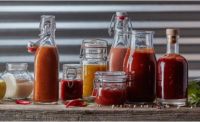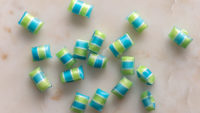2022 PREDICTIONS | COLORINGS
Developers, Manufacturers Expect Continued Demand for Natural Color Additives
Developers leverage color-carrying raw ingredients to create cleaner lines and an improved perception of health

Artificial food color usage continues to decline, reinforcing that consumers are reading labels and clean-label is here to stay.
IMAGE COURTESY OF: Food Ingredient Solutions Inc.

While consumers continue to demand natural colorants, ingredient technologists are advancing the technology to render those colorants stable and vivid.
IMAGE COURTESY OF: Kalsec, Inc.


In the world of food colorants, the anti-artificial trend governs the space today, with natural colors appearing in about 75% of new food product launches. Consumers still use their eyes to choose foods, but they want the ingredients, including (and sometimes especially) any colors, to be derived from biological sources, such as fruits, vegetables, flowers, and other botanicals.
The pigments, flavors, and nutraceutical compounds of many of these plant-derived coloring ingredients are retained during the extraction process, allowing the resulting product to be used as a functional ingredient within food products, rather than as a color additive. This growing method of natural color usage allows developers and brands to leverage the “health halo” of certain color-carrying raw ingredients, creating cleaner ingredient lines and an improved perception of healthfulness.
As younger consumers come into their own and increase their purchasing power, developers and brands will also need to deliver on desires for nostalgia and novelty among this group. Bright shades that convey vitality and freshness—while also reminding these consumers of their youth—will be in high demand going into 2022 and beyond, as more intense food hues are associated with a greater perception of flavor.
Looking ahead in the natural color space, the major challenge and opportunity is in filling in the palette gaps that currently exist. For example, natural blues, purples, greens, and browns have historically been created by combining two or more natural hues. This method can be time-consuming, costly, and only marginally effective due to differences in consistency of the sources.
The future of natural food color innovation is focused on identifying new and safe agricultural sources of desirable pigments. It also includes fostering the sustainable cultivation of these inputs via investment in agricultural infrastructure. From there, the key is to develop cost-effective, clean extraction techniques for harvesting the natural colorants on an industrial scale.
Butterfly pea flower extract, which was granted FDA approval for use as a color additive in September of this year, is one example of a new wave of naturally derived food colors. This natural color is heat-stable and water-soluble, yet retains high concentrations of anthocyanins, which give it a bright blue color. The versatility and effectiveness of this natural blue shade will significantly streamline the R&D process for blue-, purple-, and green-hued products.
Similarly, other major food color shade ranges, such as caramels and whites, are getting a natural makeover. This is coming about as consumer concerns persist around the safety of certain artificial color ingredients, such as 4-methylimidazole (4-MEI) and titanium dioxide (TiO2).
Brown, tan, and gold shades of classic caramels are being replaced with naturally brown pigments from foodstuffs such as wheat, apples, and upcycled grains. And according to Mintel, TiO2 usage for white color in foods has dropped by nearly 40% since 2010. Meanwhile, the intense white pigment of TiO2 had been difficult to match, with calcium carbonate being the closest replacement. There was no plant-based counterpart until a rice starch-derived white was developed only a few years ago. The new whites came just in time for Europe, which recently declared a ban on TiO2 in foods beginning January 1, 2022.
Looking to 2022 and beyond, consumer preferences will continue to drive the market toward embracing a cleaner, more natural food color portfolio. Developers and manufacturers can expect to see high demand for shades associated with wholesomeness and high nutritive value. Oranges, yellows, blues, and purples extracted from antioxidant-rich foods such as turmeric, carrots, and berries will help to secure consumers who are expecting to see recognizable ingredients that are already associated with health.
Innovation in the natural colors space will continue to focus on the cultivation and extraction of novel, functional, and sustainable coloring foodstuffs to replace artificial counterparts in all shades of the food color spectrum.
Regular contributor Olivia Conrad is a product development scientist and freelance science writer in Boulder, CO, with a degree in Food Science from the University of Maine. She has extensive experience in natural foods product development in categories ranging from frozen desserts to meat snacks. She also is an expert in food safety with a strong working knowledge of FSMA and HACCP principles. She may be contacted at oconrad2013@gmail.com.
Looking for a reprint of this article?
From high-res PDFs to custom plaques, order your copy today!







